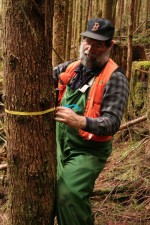A new study published in the journal Science documents an increase in tree mortality rate in old-growth forests across the West during the past 50 years. The increase in mortality affects all sizes and common species of trees. The documented doubling of mortality rates over the past few decades could significantly change forest composition and structure.
The authors considered several possible causes of the increase in mortality, including competition and aging of older trees, and concluded that stress related to climate warming is the best explanation. This increase in so-called background mortality is not as obvious as large fire or insect killed stands of trees, but given the large areas of "undisturbed" forests, it could have equivalent impact on the carbon cycle. As more trees die the forests will absorb less carbon dioxide from the atmosphere.
This work is based on long-term forest plots established decades ago, many by Jerry Franklin and associates, at the HJ Andrews LTER, Cascade Head, and Wind River Experimental Forests and several National Parks in Washington and California. The study highlights the importance of maintaining long-term experiments and observation programs.
Andrews LTER scientist Mark Harmon, one of the paper's authors and professor of forest science at Oregon State University, observed, "This exploratory analysis points us in the direction of new studies of the existing long-term data. For example, we need to examine records for trees in the 100-200 year age class and probe the mechanisms of mortality. We also need to examine what is happening to these dead trees-are there enough to turn the stands into carbon sources for the atmosphere? It is essential to keep these and similar observations going."
The article, "Widespread Increase of Tree Mortality Rates in the Western United States", is available online at http://www.sciencemag.org/cgi/content/full/323/5913/521.

 Enlarge this image
Enlarge this image